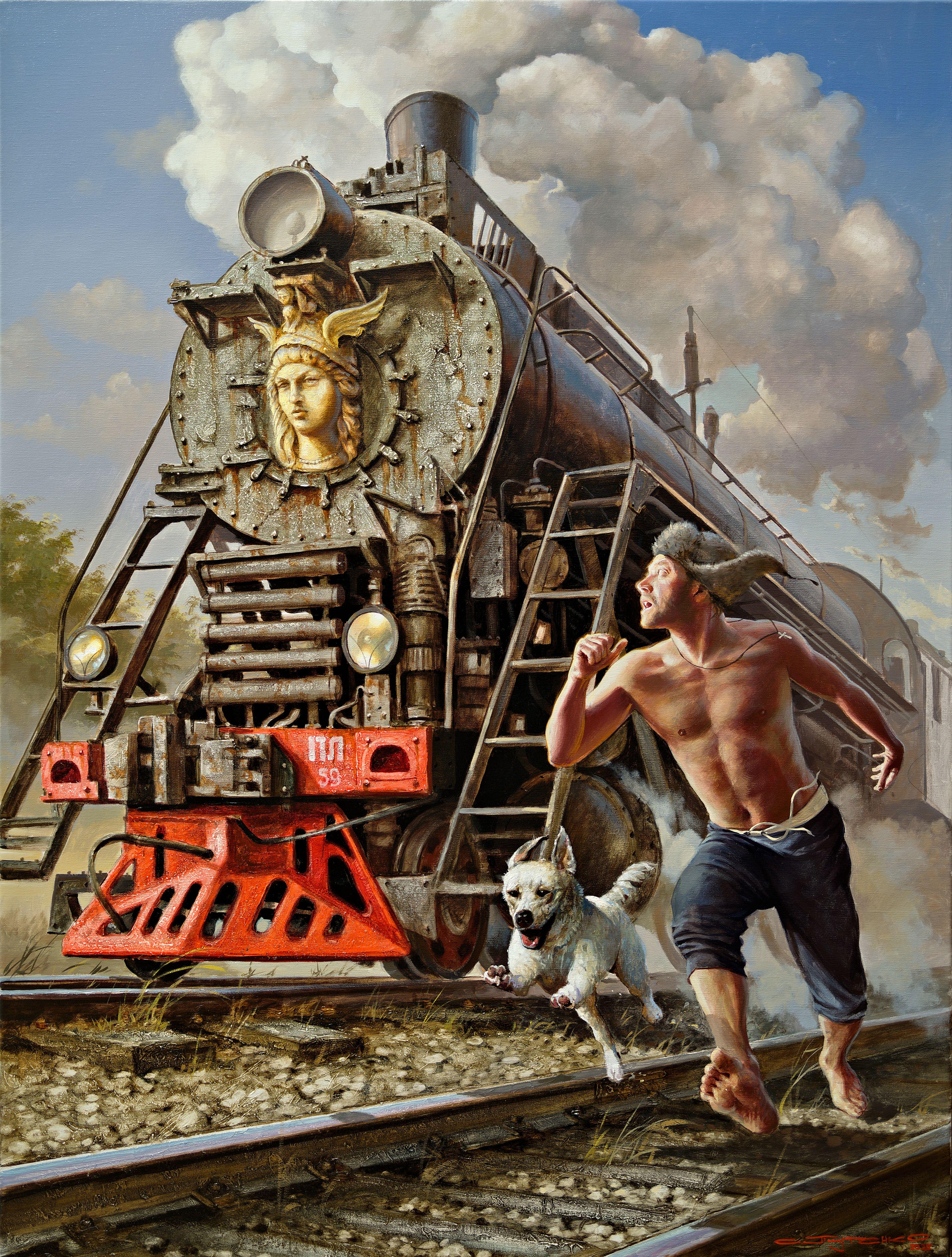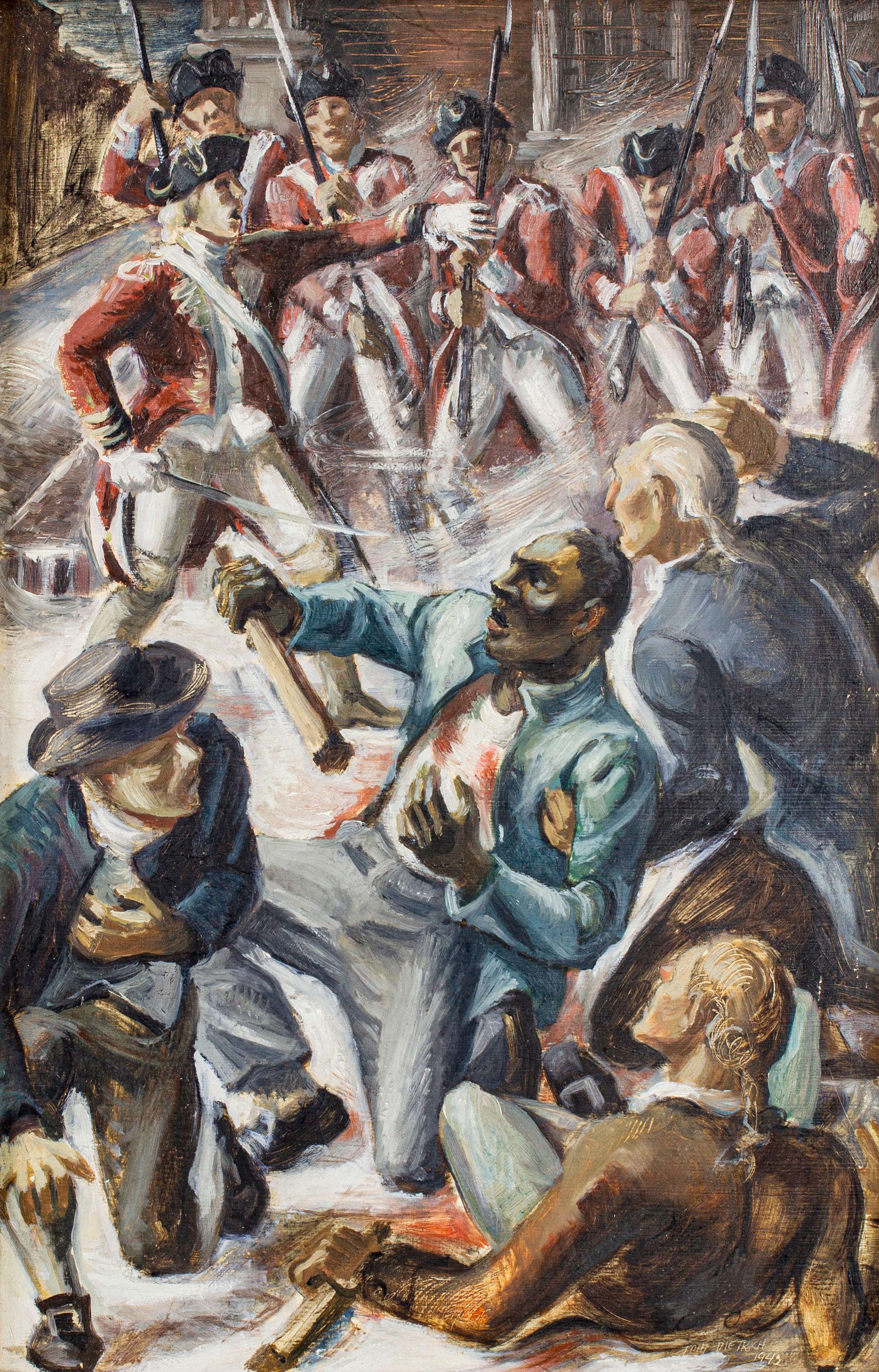Items Similar to Penny Candy, The Saturday Evening Post Cover
Want more images or videos?
Request additional images or videos from the seller
1 of 7
Stevan DohanosPenny Candy, The Saturday Evening Post Cover1944
1944
About the Item
Signed Lower Right by Artist
The Saturday Evening Post Cover, September 23, 1944
A proponent of simplicity as a virtue, Stevan Dohanos has said, "A clean, strong, uncluttered image forms the basis of a good picture." Prior to the introduction of television as a medium, The Saturday Evening Post had great influence, as it was likely the most widely followed exponent of American popular culture. Dohanos' work appeared frequently on its covers, making the artist seem to be their cultural spokesperson.
Dohanos painted over one-hundred and twenty-five Saturday Evening Post covers during the 1940's and 50's, illustrating scenes of American life including baseball games, ice cream, mobile homes, gas stations, children with toys or butterfly collections, barns, and families enjoying all walks of ordinary life. Of the many masterworks Dohanos created, Penny Candy, the cover of the September 23, 1944 Saturday Evening Post, is widely considered his tour de force; his Mona Lisa.
One cannot discuss the illustration art of Dohanos without mentioning Norman Rockwell, because their Saturday Evening Post cover images are invariable compared. Dohanos along with Rockwell came to represent the quintessence of American magazine illustrators. His images were generally slightly humorous, optimistic, manifesting the best of American ideals, and they were always familiar to the reader. Dohanos is considered "The Delineator of the Heart of America."
Whereas Rockwell was noted for idealizing Americans and their way of life, Dohanos had an all-consuming love for the common everyday things in life. He stated "As an artist I have always gloried in finding beauty in the ordinary things of life." He named Grant Wood and Edward Hopper as the greatest influences on his painting.
Dohanos was also influenced by early twentieth-century American Ash Can painters known as 'The Eight' (Robert Henri, John Sloan, William Glackens, Everett Shinn, Maurice Prendergast, Arthur B. Davies, Ernest Lawson, George Luks) and the realistic depictions they painted, saying, "the truth and quality of the art could not be long denied." He was truer to fact and form than Rockwell who tended to over indicate and exaggerate. The difference between the two illustrators is more obvious in their choice of subjects rather than in their techniques. It is said that Dohanos focused more on the locale of the people he portrayed rather than the people themselves, making him more objective than Rockwell.
Dohanos was known for taking infinite pains in creating his illustrations. Often, they harked back to people and places from his childhood or incidents he observed in rambling about the countryside. Whatever scenes they represented, his paintings were illuminated by his kind, earthy humor and his passionate love for the American scene.
In his masterful and cinematic Penny Candy, Dohanos depicts a scene right out of every person's childhood storybook: A young boy, dressed like Howdy Doody in his rough and tumble, tattered and torn red shirt and bandana, stands with his muddied legs firmly rooted and his soiled hands hidden behind his back, as he takes a break from his playtime shenanigans to buy himself a cheap treat. He gazes at the assortment of penny candy laid out before him like a sea of gold, as the elderly counter man stares off, head in hand and mind elsewhere, bored and daydreaming, waiting for his little patron to select a sweet treat.
Every detail of this composition is painted impeccably, as the artist spared no artistic element in creating this flawless scene: Each colorful gumball shines, every sheet of paper above the cash register is delineated, every hair on the figures' heads is unique. The painting explodes with color, form, light and shadow, resulting in what is arguably the finest and most complex scene the artist produced. It is no wonder that one cannot walk into a vacation town candy Shoppe without seeing a poster of this very work.
The image of Penny Candy may be found today in many iterations: As posters, puzzles, magnets, and calendars, and mugs. It is fitting that the artist's sensitive portrayals of common American subjects have landed his paintings in the permanent collections of the Cleveland Museum of Art, the Whitney Museum of American Art, New York, the Pennsylvania Academy of the Fine Arts, and Dartmouth College, among many others.
- Creator:Stevan Dohanos (1907-1995, American)
- Creation Year:1944
- Dimensions:Height: 27.25 in (69.22 cm)Width: 21.75 in (55.25 cm)
- Medium:
- Period:
- Condition:
- Gallery Location:Fort Washington, PA
- Reference Number:
About the Seller
5.0
Recognized Seller
These prestigious sellers are industry leaders and represent the highest echelon for item quality and design.
Established in 1995
1stDibs seller since 2016
107 sales on 1stDibs
Typical response time: 5 hours
- ShippingRetrieving quote...Ships From: Fort Washington, PA
- Return PolicyA return for this item may be initiated within 14 days of delivery.
More From This SellerView All
- "Is Geography Distracting You From the World Series?By Charles KerinsLocated in Fort Washington, PASignature: Signed Lower Left Original cover for The Catholic Boy magazine, published September 1952. Captioned on the first page of the magazine: "Is geography distracting you from ...Category
1950s Figurative Paintings
MaterialsTempera, Board
- The Head and the Heart, American Magazine Story IllustrationBy Arthur SarnoffLocated in Fort Washington, PADate: 1951 Medium: Gouache and Tempera on Board Dimensions: 10.25" x 12.50" Signature: Signed Lower Right The Head and the Heart, American Magazine story illustration, September 1951Category
1950s Figurative Paintings
MaterialsTempera, Gouache, Board
- Santa Claus Amoco AdvertisementBy Harry FredmanLocated in Fort Washington, PADate: 1960 Medium: Gouache and Tempera on Board Dimensions: 11.25" x 24.25" Signature: Signed Lower Left "I switched too..." AmocoCategory
1960s Portrait Paintings
MaterialsTempera, Gouache, Board
- Class Reunion Gone WrongBy Monte CrewsLocated in Fort Washington, PAMedium: Tempera and Gouache on Paper Dimensions: 10.50" x 14.00" Signature: Signed Lower RightCategory
Early 20th Century Figurative Paintings
MaterialsPaper, Tempera, Gouache
- Christmas TreeBy Charlotte SternbergLocated in Fort Washington, PAMedium: Egg Tempera on Gesso Panel Signature: UnsignedCategory
1960s Still-life Paintings
MaterialsGesso, Egg Tempera, Panel
- Chasing the SleighBy Charlotte SternbergLocated in Fort Washington, PAMedium: Egg Tempera on Illustration Board Signature: UnsignedCategory
1950s Landscape Paintings
MaterialsEgg Tempera, Illustration Board
You May Also Like
- Flying in DreamsLocated in Naples, FLCharacterized by his deeply honest means of expression and fascination with Orientalism, Surrealism, and social commentary, Moscow painter Stanislav Plutenko...Category
2010s Surrealist Landscape Paintings
MaterialsOil, Egg Tempera
- The Storm ApproachesLocated in Naples, FLOriginal oil on canvas.Category
2010s Realist Animal Paintings
MaterialsOil, Egg Tempera
- The RaceLocated in Naples, FLCharacterized by his deeply honest means of expression and fascination with Orientalism, Surrealism, and social commentary, Moscow painter Stanislav Plutenko...Category
2010s Surrealist Figurative Paintings
MaterialsOil, Egg Tempera
- Oil Painting Titled "The Death of Crispus Attucks", by Thomas Dietrich, 1943Located in New York, NYThomas M. Dietrich 1912-1998 The Death of Crispus Attucks, 1943 Tempera and oil on board 21 x 15 inches Signed and dated: Tom Dietrich 1943 Thomas M. Dietrich was an artist in residence at Lawrence College for 30 years and painted in the American Regionalist style. He exhibited yearly at the Art Institute of Chicago where he also received the acclaimed International William Tuthill Prize for watercolors in 1941 (Charles Burchfield won the associated Logan prize that same year) Dietrich also received a Louis Comfort Tiffany Foundation fellowship and was a founding member of the Wisconsin Watercolor Society. In 1943 Deitrich painted The Death of Crispus Attucks, depicting the historical battle known as the Boston Massacre...Category
1940s Figurative Paintings
MaterialsOil, Tempera
- Ceremonial Dancers oil and tempera painting by Julio De DiegoBy Julio de DiegoLocated in Hudson, NYArtwork measures 48" x 30" and framed 56 ¼" x 38 ¼" x 3" Provenance: John Heller Gallery, NYC, circa 1975 (label verso) The artist's daughter Corbino Galleries, Sarasota, FL (1990)...Category
1940s Modern Abstract Paintings
MaterialsMasonite, Oil, Tempera
- The Magician oil and tempera painting by Julio de DiegoBy Julio de DiegoLocated in Hudson, NYJulio De Diego’s Atomic Series paintings made an extraordinary statement regarding the shock and fear that accompanied the dawn of the nuclear age. In the artist’s own words, “Scientists were working secretly to develop formidable powers taken from the mysterious depths of the earth - with the power to make the earth useless! Then, the EXPLOSION! . . . we entered the Atomic Age, and from there the neo-Atomic war begins. Explosions fell everywhere and man kept on fighting, discovering he could fight without flesh.” To execute these works, De Diego developed a technique of using tempera underpainting before applying layer upon layer of pigmented oil glazes. The result is paintings with surfaces which were described as “bonelike” in quality. The forms seem to float freely, creating a three-dimensional visual effect. In the 1954 book The Modern Renaissance in American Art, author Ralph Pearson summarizes the series as “a fantastic interpretation of a weighty theme. Perhaps it is well to let fantasy and irony appear to lighten the devastating impact. By inverse action, they may in fact increase its weight.” Exhibited 1964 Marion Koogler McNay Art Institute, San Antonio, Texas This work retains its original frame which measures 54" x 42" x 2" About this artist: Julio De Diego crafted a formidable persona within the artistic developments and political struggles of his time. The artist characterized his own work as “lyrical,” explaining, “through the years, the surrealists, the social-conscious painters and the others tried to adopt me, but I went my own way, good, bad or indifferent.” [1] His independence manifested early in life when de Diego left his parent’s home in Madrid, Spain, in adolescence following his father’s attempts to curtail his artistic aspirations. At the age of fifteen he held his first exhibition, set up within a gambling casino. He managed to acquire an apprenticeship in a studio producing scenery for Madrid’s operas, but moved from behind the curtains to the stage, trying his hand at acting and performing as an extra in the Ballet Russes’ Petrouchka with Nijinsky. He spent several years in the Spanish army, including a six-month stretch in the Rif War of 1920 in Northern Africa. His artistic career pushed ahead as he set off for Paris and became familiar with modernism’s forays into abstraction, surrealism, and cubism. The artist arrived in the U.S. in 1924 and settled in Chicago two years later. He established himself with a commission for the decoration of two chapels in St. Gregory’s Church. He also worked in fashion illustration, designed magazine covers and developed a popular laundry bag for the Hotel Sherman. De Diego began exhibiting through the Art Institute of Chicago in 1929, and participated in the annual Chicago Artists Exhibitions, Annual American Exhibitions, and International Water Color Exhibitions. He held a solo exhibition at the Art Institute of Chicago in the summer of 1935. Though the artist’s career was advancing, his family life had deteriorated. In 1932 his first marriage dissolved, and the couple’s young daughter Kiriki was sent to live with friend Paul Hoffman. De Diego continued to develop his artistic vocabulary with a growing interest in Mexican art. He traveled throughout the country acquainting himself with the works of muralists such as Carlos Merida, and also began a collection of small native artifacts...Category
1940s American Modern Abstract Paintings
MaterialsMasonite, Oil, Tempera
Recently Viewed
View AllMore Ways To Browse
Gumball Vintage
Vintage Penny Toys
Vintage Poster Calendar
Vintage Poster Calendars
Vintage Posters Calendar
Mobile Gas
Paintings Of Baseball
Mobile Tv
Vintage Sea Illustration
Vintage Mug Collection
Cleveland Baseball
Vintage Sea Picture
Poster Ice Cream
Storybook Light
Vintage Saturday Evening Post Covers
Saturday Evening Post Cover Artists
Compass Camera
Saturday Evening Post 1941





